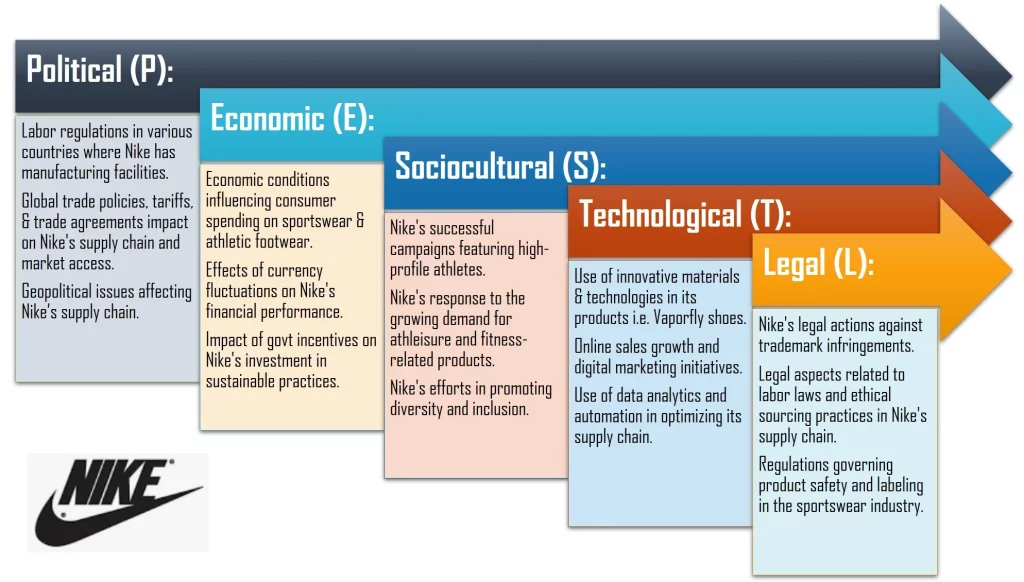
Below is a sample PESTLE analysis essay on Nike Inc. This example is intended to help students write better business PESTLE analysis essays.
Nike PESTLE Analysis Essay
PESTLE Analysis Essay Outline: Nike Inc.
Here is the outline for this sample PESTLE analysis essay:
- Introduction
- Brief introduction to Nike and its global prominence in the sportswear and athletic footwear industry.
- Significance of conducting a PESTLE analysis for Nike’s strategic evaluation.
- Purpose of the essay: to analyze the external macro-environmental factors affecting Nike.
- Political Factors
- Government Regulations
- Exploration of government regulations influencing Nike’s manufacturing processes and product distribution.
- Example: Assessment of labor regulations in various countries where Nike has manufacturing facilities.
- International Trade Policies
- Examination of how global trade policies, tariffs, and trade agreements impact Nike’s supply chain and market access.
- Example: Analysis of the impact of trade tensions on Nike’s production costs.
- Political Stability
- Discussion on the importance of political stability in the countries where Nike operates and its influence on business operations.
- Example: Evaluation of Nike’s response to geopolitical issues affecting its supply chain.
- Economic Factors
- Consumer Spending on Sportswear
- Analysis of economic conditions influencing consumer spending on sportswear and athletic footwear.
- Example: Consideration of Nike’s performance during economic downturns and recessions.
- Currency Exchange Rates
- Examination of how currency exchange rates impact Nike’s international operations, pricing, and profit margins.
- Example: Analysis of the effects of currency fluctuations on Nike’s financial performance.
- Economic Incentives
- Exploration of economic incentives, such as tax policies or subsidies, that influence Nike’s business operations.
- Example: Assessment of the impact of government incentives on Nike’s investment in sustainable practices.
- Sociocultural Factors
- Athlete Endorsements and Influences
- Analysis of societal attitudes towards athlete endorsements and influences on Nike’s brand image.
- Example: Evaluation of Nike’s successful campaigns featuring high-profile athletes.
- Health and Wellness Trends
- Examination of trends in health and wellness that impact consumer preferences for sportswear.
- Example: Consideration of Nike’s response to the growing demand for athleisure and fitness-related products.
- Diversity and Inclusion
- Discussion on societal expectations regarding diversity and inclusion and Nike’s initiatives in this regard.
- Example: Assessment of Nike’s efforts in promoting diversity and inclusion in its marketing campaigns.
- Technological Factors
- Innovation in Sportswear Technology
- Analysis of technological advancements in sportswear and athletic footwear that influence Nike’s product development.
- Example: Evaluation of Nike’s use of innovative materials and technologies in its products.
- E-Commerce and Digital Trends
- Examination of the impact of e-commerce and digital trends on Nike’s distribution and marketing strategies.
- Example: Analysis of Nike’s online sales growth and digital marketing initiatives.
- Supply Chain Technology
- Exploration of technological solutions in Nike’s supply chain management.
- Example: Assessment of Nike’s use of data analytics and automation in optimizing its supply chain.
- Legal Factors
- Intellectual Property Protection
- Analysis of legal considerations related to Nike’s intellectual property protection.
- Example: Evaluation of Nike’s legal actions against trademark infringements.
- Labor Laws and Ethical Sourcing
- Examination of legal aspects related to labor laws and ethical sourcing practices in Nike’s supply chain.
- Example: Consideration of Nike’s efforts to address labor practices in its overseas factories.
- Product Regulations
- Discussion on legal regulations governing product safety and labeling in the sportswear industry.
- Example: Assessment of Nike’s compliance with product safety standards.
- Environmental Factors
- Sustainable Practices
- Analysis of Nike’s commitment to environmental sustainability in its manufacturing processes.
- Example: Evaluation of Nike’s initiatives to reduce environmental impact, such as sustainable materials and waste reduction.
- Climate Change Risks
- Examination of environmental risks, such as climate change, and their potential impact on Nike’s supply chain.
- Example: Consideration of Nike’s strategies to address climate-related risks.
- Packaging Sustainability
- Exploration of Nike’s efforts towards sustainable packaging practices.
- Example: Assessment of Nike’s use of eco-friendly materials and packaging designs.
- Conclusion
- Summarization of key findings from the PESTLE analysis.
- Implications of external factors for Nike’s strategic decision-making.
- Overall assessment of Nike’s resilience and adaptability in the face of macro-environmental changes.

